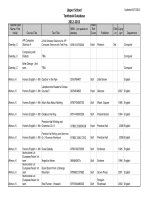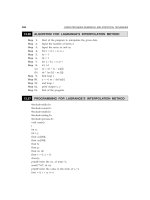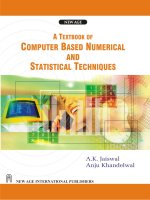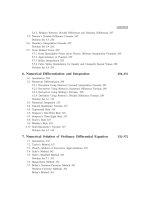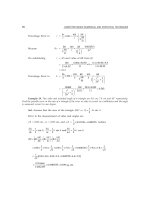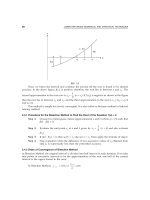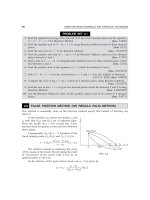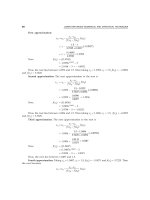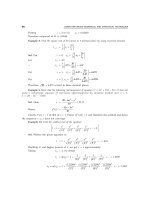Textbook (2)
Bạn đang xem bản rút gọn của tài liệu. Xem và tải ngay bản đầy đủ của tài liệu tại đây (29.33 MB, 793 trang )
In Praise of Computer Organization and Design: The Hardware/
Software Interface, Fifth Edition
“Textbook selection is often a frustrating act of compromise—pedagogy, content
coverage, quality of exposition, level of rigor, cost. Computer Organization and
Design is the rare book that hits all the right notes across the board, without
compromise. It is not only the premier computer organization textbook, it is a
shining example of what all computer science textbooks could and should be.”
—Michael Goldweber, Xavier University
“I have been using Computer Organization and Design for years, from the very
first edition. The new Fifth Edition is yet another outstanding improvement on an
already classic text. The evolution from desktop computing to mobile computing
to Big Data brings new coverage of embedded processors such as the ARM, new
material on how software and hardware interact to increase performance, and
cloud computing. All this without sacrificing the fundamentals.”
—Ed Harcourt, St. Lawrence University
“To Millennials: Computer Organization and Design is the computer architecture
book you should keep on your (virtual) bookshelf. The book is both old and new,
because it develops venerable principles—Moore's Law, abstraction, common case
fast, redundancy, memory hierarchies, parallelism, and pipelining—but illustrates
them with contemporary designs, e.g., ARM Cortex A8 and Intel Core i7.”
—Mark D. Hill, University of Wisconsin-Madison
“The new edition of Computer Organization and Design keeps pace with advances
in emerging embedded and many-core (GPU) systems, where tablets and
smartphones will are quickly becoming our new desktops. This text acknowledges
these changes, but continues to provide a rich foundation of the fundamentals
in computer organization and design which will be needed for the designers of
hardware and software that power this new class of devices and systems.”
—Dave Kaeli, Northeastern University
“The Fifth Edition of Computer Organization and Design provides more than an
introduction to computer architecture. It prepares the reader for the changes necessary
to meet the ever-increasing performance needs of mobile systems and big data
processing at a time that difficulties in semiconductor scaling are making all systems
power constrained. In this new era for computing, hardware and software must be codesigned and system-level architecture is as critical as component-level optimizations.”
—Christos Kozyrakis, Stanford University
“Patterson and Hennessy brilliantly address the issues in ever-changing computer
hardware architectures, emphasizing on interactions among hardware and software
components at various abstraction levels. By interspersing I/O and parallelism concepts
with a variety of mechanisms in hardware and software throughout the book, the new
edition achieves an excellent holistic presentation of computer architecture for the
PostPC era. This book is an essential guide to hardware and software professionals
facing energy efficiency and parallelization challenges in Tablet PC to cloud computing.”
—Jae C. Oh, Syracuse University
This page intentionally left blank
F
I F
T
H
E
D
I
T
I
O
N
Computer Organization and Design
T H E
H A R D W A R E / S O F T W A R E
I N T E R FA C E
David A. Patterson has been teaching computer architecture at the University of
California, Berkeley, since joining the faculty in 1977, where he holds the Pardee Chair
of Computer Science. His teaching has been honored by the Distinguished Teaching
Award from the University of California, the Karlstrom Award from ACM, and the
Mulligan Education Medal and Undergraduate Teaching Award from IEEE. Patterson
received the IEEE Technical Achievement Award and the ACM Eckert-Mauchly Award
for contributions to RISC, and he shared the IEEE Johnson Information Storage Award
for contributions to RAID. He also shared the IEEE John von Neumann Medal and
the C & C Prize with John Hennessy. Like his co-author, Patterson is a Fellow of the
American Academy of Arts and Sciences, the Computer History Museum, ACM,
and IEEE, and he was elected to the National Academy of Engineering, the National
Academy of Sciences, and the Silicon Valley Engineering Hall of Fame. He served on
the Information Technology Advisory Committee to the U.S. President, as chair of the
CS division in the Berkeley EECS department, as chair of the Computing Research
Association, and as President of ACM. This record led to Distinguished Service Awards
from ACM and CRA.
At Berkeley, Patterson led the design and implementation of RISC I, likely the first
VLSI reduced instruction set computer, and the foundation of the commercial
SPARC architecture. He was a leader of the Redundant Arrays of Inexpensive Disks
(RAID) project, which led to dependable storage systems from many companies.
He was also involved in the Network of Workstations (NOW) project, which led to
cluster technology used by Internet companies and later to cloud computing. These
projects earned three dissertation awards from ACM. His current research projects
are Algorithm-Machine-People and Algorithms and Specializers for Provably Optimal
Implementations with Resilience and Efficiency. The AMP Lab is developing scalable
machine learning algorithms, warehouse-scale-computer-friendly programming
models, and crowd-sourcing tools to gain valuable insights quickly from big data in
the cloud. The ASPIRE Lab uses deep hardware and software co-tuning to achieve the
highest possible performance and energy efficiency for mobile and rack computing
systems.
John L. Hennessy is the tenth president of Stanford University, where he has been
a member of the faculty since 1977 in the departments of electrical engineering and
computer science. Hennessy is a Fellow of the IEEE and ACM; a member of the
National Academy of Engineering, the National Academy of Science, and the American
Philosophical Society; and a Fellow of the American Academy of Arts and Sciences.
Among his many awards are the 2001 Eckert-Mauchly Award for his contributions to
RISC technology, the 2001 Seymour Cray Computer Engineering Award, and the 2000
John von Neumann Award, which he shared with David Patterson. He has also received
seven honorary doctorates.
In 1981, he started the MIPS project at Stanford with a handful of graduate students.
After completing the project in 1984, he took a leave from the university to cofound
MIPS Computer Systems (now MIPS Technologies), which developed one of the first
commercial RISC microprocessors. As of 2006, over 2 billion MIPS microprocessors have
been shipped in devices ranging from video games and palmtop computers to laser printers
and network switches. Hennessy subsequently led the DASH (Director Architecture
for Shared Memory) project, which prototyped the first scalable cache coherent
multiprocessor; many of the key ideas have been adopted in modern multiprocessors.
In addition to his technical activities and university responsibilities, he has continued to
work with numerous start-ups both as an early-stage advisor and an investor.
F
I F
T
H
E
D
I
T
I
O
N
Computer Organization and Design
T H E
H A R D W A R E / S O F T W A R E
I N T E R FA C E
David A. Patterson
University of California, Berkeley
John L. Hennessy
Stanford University
With contributions by
Perry Alexander
The University of Kansas
David Kaeli
Northeastern University
Kevin Lim
Hewlett-Packard
Nicole Kaiyan
University of Adelaide
John Nickolls
NVIDIA
David Kirk
NVIDIA
John Oliver
Cal Poly, San Luis Obispo
Javier Bruguera
Universidade de Santiago de Compostela
James R. Larus
School of Computer and
Communications Science at EPFL
Milos Prvulovic
Georgia Tech
Jichuan Chang
Hewlett-Packard
Jacob Leverich
Hewlett-Packard
Peter J. Ashenden
Ashenden Designs Pty Ltd
Jason D. Bakos
University of South Carolina
Matthew Farrens
University of California, Davis
AMSTERDAM • BOSTON • HEIDELBERG • LONDON
NEW YORK • OXFORD • PARIS • SAN DIEGO
SAN FRANCISCO • SINGAPORE • SYDNEY • TOKYO
Morgan Kaufmann is an imprint of Elsevier
Partha Ranganathan
Hewlett-Packard
Acquiring Editor: Todd Green
Development Editor: Nate McFadden
Project Manager: Lisa Jones
Designer: Russell Purdy
Morgan Kaufmann is an imprint of Elsevier
The Boulevard, Langford Lane, Kidlington, Oxford, OX5 1GB
225 Wyman Street, Waltham, MA 02451, USA
Copyright © 2014 Elsevier Inc. All rights reserved
No part of this publication may be reproduced or transmitted in any form or by any means, electronic or mechanical, including
photocopying, recording, or any information storage and retrieval system, without permission in writing from the publisher. Details on how
to seek permission, further information about the Publisher’s permissions policies and our arrangements with organizations such as the
Copyright Clearance Center and the Copyright Licensing Agency, can be found at our website: www.elsevier.com/permissions
This book and the individual contributions contained in it are protected under copyright by the Publisher (other than as may be noted
herein).
Notices
Knowledge and best practice in this field are constantly changing. As new research and experience broaden our understanding, changes in
research methods or professional practices, may become necessary. Practitioners and researchers must always rely on their own experience
and knowledge in evaluating and using any information or methods described herein. In using such information or methods they should be
mindful of their own safety and the safety of others, including parties for whom they have a professional responsibility.
To the fullest extent of the law, neither the publisher nor the authors, contributors, or editors, assume any liability for any injury and/
or damage to persons or property as a matter of products liability, negligence or otherwise, or from any use or operation of any methods,
products, instructions, or ideas contained in the material herein.
Library of Congress Cataloging-in-Publication Data
Patterson, David A.
Computer organization and design: the hardware/software interface/David A. Patterson, John L. Hennessy. — 5th ed.
p. cm. — (The Morgan Kaufmann series in computer architecture and design)
Rev. ed. of: Computer organization and design/John L. Hennessy, David A. Patterson. 1998.
Summary: “Presents the fundamentals of hardware technologies, assembly language, computer arithmetic, pipelining, memory hierarchies
and I/O”— Provided by publisher.
ISBN 978-0-12-407726-3 (pbk.)
1. Computer organization. 2. Computer engineering. 3. Computer interfaces. I. Hennessy, John L. II. Hennessy, John L. Computer
organization and design. III. Title.
British Library Cataloguing-in-Publication Data
A catalogue record for this book is available from the British Library
ISBN: 978-0-12-407726-3
For information on all MK publications visit our
website at www.mkp.com
Printed and bound in the United States of America
13 14 15 16
10 9 8 7 6 5 4 3 2 1
To Linda,
who has been, is, and always will be the love of my life
A C K N O W L E D G M E N T S
Figures 1.7, 1.8 Courtesy of iFixit (www.ifixit.com).
Figure 1.9 Courtesy of Chipworks (www.chipworks.com).
Figure 1.13 Courtesy of Intel.
Figures 1.10.1, 1.10.2, 4.15.2 Courtesy of the Charles Babbage
Institute, University of Minnesota Libraries, Minneapolis.
Figures 1.10.3, 4.15.1, 4.15.3, 5.12.3, 6.14.2 Courtesy of IBM.
Figure 1.10.4 Courtesy of Cray Inc.
Figure 1.10.5 Courtesy of Apple Computer, Inc.
Figure 1.10.6 Courtesy of the Computer History Museum.
Figures 5.17.1, 5.17.2 Courtesy of Museum of Science, Boston.
Figure 5.17.4 Courtesy of MIPS Technologies, Inc.
Figure 6.15.1 Courtesy of NASA Ames Research Center.
Contents
Preface xv
C H A P T E R S
1
Computer Abstractions and Technology 2
1.1
1.2
1.3
1.4
1.5
1.6
1.7
1.8
1.9
1.10
1.11
1.12
1.13
2
Introduction 3
Eight Great Ideas in Computer Architecture 11
Below Your Program 13
Under the Covers 16
Technologies for Building Processors and Memory 24
Performance 28
The Power Wall 40
The Sea Change: The Switch from Uniprocessors to
Multiprocessors 43
Real Stuff: Benchmarking the Intel Core i7 46
Fallacies and Pitfalls 49
Concluding Remarks 52
Historical Perspective and Further Reading 54
Exercises 54
Instructions: Language of the Computer 60
2.1
2.2
2.3
2.4
2.5
2.6
2.7
2.8
2.9
2.10
2.11
2.12
2.13
2.14
Introduction 62
Operations of the Computer Hardware 63
Operands of the Computer Hardware 66
Signed and Unsigned Numbers 73
Representing Instructions in the Computer 80
Logical Operations 87
Instructions for Making Decisions 90
Supporting Procedures in Computer Hardware 96
Communicating with People 106
MIPS Addressing for 32-Bit Immediates and Addresses 111
Parallelism and Instructions: Synchronization 121
Translating and Starting a Program 123
A C Sort Example to Put It All Together 132
Arrays versus Pointers 141
x
Contents
2.15
2.16
2.17
2.18
2.19
2.20
2.21
2.22
3
Advanced Material: Compiling C and Interpreting Java 145
Real Stuff: ARMv7 (32-bit) Instructions 145
Real Stuff: x86 Instructions 149
Real Stuff: ARMv8 (64-bit) Instructions 158
Fallacies and Pitfalls 159
Concluding Remarks 161
Historical Perspective and Further Reading 163
Exercises 164
Arithmetic for Computers 176
3.1
3.2
3.3
3.4
3.5
3.6
3.7
Introduction 178
Addition and Subtraction 178
Multiplication 183
Division 189
Floating Point 196
Parallelism and Computer Arithmetic: Subword Parallelism 222
Real Stuff: Streaming SIMD Extensions and Advanced Vector
Extensions in x86 224
3.8 Going Faster: Subword Parallelism and Matrix Multiply 225
3.9 Fallacies and Pitfalls 229
3.10 Concluding Remarks 232
3.11 Historical Perspective and Further Reading 236
3.12 Exercises 237
4
The Processor 242
4.1
4.2
4.3
4.4
4.5
4.6
4.7
4.8
4.9
4.10
4.11
4.12
Introduction 244
Logic Design Conventions 248
Building a Datapath 251
A Simple Implementation Scheme 259
An Overview of Pipelining 272
Pipelined Datapath and Control 286
Data Hazards: Forwarding versus Stalling 303
Control Hazards 316
Exceptions 325
Parallelism via Instructions 332
Real Stuff: The ARM Cortex-A8 and Intel Core i7 Pipelines 344
Going Faster: Instruction-Level Parallelism and Matrix
Multiply 351
4.13 Advanced Topic: An Introduction to Digital Design Using a Hardware
Design Language to Describe and Model a Pipeline and More Pipelining
Illustrations 354
Contents
4.14
4.15
4.16
4.17
5
Large and Fast: Exploiting Memory Hierarchy 372
5.1
5.2
5.3
5.4
5.5
5.6
5.7
5.8
5.9
5.10
5.11
5.12
5.13
5.14
5.15
5.16
5.17
5.18
6
Fallacies and Pitfalls 355
Concluding Remarks 356
Historical Perspective and Further Reading 357
Exercises 357
Introduction 374
Memory Technologies 378
The Basics of Caches 383
Measuring and Improving Cache Performance 398
Dependable Memory Hierarchy 418
Virtual Machines 424
Virtual Memory 427
A Common Framework for Memory Hierarchy 454
Using a Finite-State Machine to Control a Simple Cache 461
Parallelism and Memory Hierarchies: Cache Coherence 466
Parallelism and Memory Hierarchy: Redundant Arrays of
Inexpensive Disks 470
Advanced Material: Implementing Cache Controllers 470
Real Stuff: The ARM Cortex-A8 and Intel Core i7 Memory
Hierarchies 471
Going Faster: Cache Blocking and Matrix Multiply 475
Fallacies and Pitfalls 478
Concluding Remarks 482
Historical Perspective and Further Reading 483
Exercises 483
Parallel Processors from Client to Cloud 500
6.1
6.2
6.3
6.4
6.5
6.6
6.7
Introduction 502
The Difficulty of Creating Parallel Processing Programs 504
SISD, MIMD, SIMD, SPMD, and Vector 509
Hardware Multithreading 516
Multicore and Other Shared Memory Multiprocessors 519
Introduction to Graphics Processing Units 524
Clusters, Warehouse Scale Computers, and Other
Message-Passing Multiprocessors 531
6.8 Introduction to Multiprocessor Network Topologies 536
6.9 Communicating to the Outside World: Cluster Networking 539
6.10 Multiprocessor Benchmarks and Performance Models 540
6.11 Real Stuff: Benchmarking Intel Core i7 versus NVIDIA Tesla
GPU 550
xi
xii
Contents
6.12
6.13
6.14
6.15
6.16
Going Faster: Multiple Processors and Matrix Multiply 555
Fallacies and Pitfalls 558
Concluding Remarks 560
Historical Perspective and Further Reading 563
Exercises 563
A P P E N D I C E S
A
Assemblers, Linkers, and the SPIM Simulator A-2
A.1
A.2
A.3
A.4
A.5
A.6
A.7
A.8
A.9
A.10
A.11
A.12
B
Introduction A-3
Assemblers A-10
Linkers A-18
Loading A-19
Memory Usage A-20
Procedure Call Convention A-22
Exceptions and Interrupts A-33
Input and Output A-38
SPIM A-40
MIPS R2000 Assembly Language A-45
Concluding Remarks A-81
Exercises A-82
The Basics of Logic Design B-2
B.1
B.2
B.3
B.4
B.5
B.6
B.7
B.8
B.9
B.10
B.11
B.12
B.13
B.14
Index I-1
Introduction B-3
Gates, Truth Tables, and Logic Equations B-4
Combinational Logic B-9
Using a Hardware Description Language B-20
Constructing a Basic Arithmetic Logic Unit B-26
Faster Addition: Carry Lookahead B-38
Clocks B-48
Memory Elements: Flip-Flops, Latches, and Registers B-50
Memory Elements: SRAMs and DRAMs B-58
Finite-State Machines B-67
Timing Methodologies B-72
Field Programmable Devices B-78
Concluding Remarks B-79
Exercises B-80
Contents
O N L I N E
C
Graphics and Computing GPUs C-2
C.1
C.2
C.3
C.4
C.5
C.6
C.7
C.8
C.9
C.10
C.11
D
Introduction C-3
GPU System Architectures C-7
Programming GPUs C-12
Multithreaded Multiprocessor Architecture C-25
Parallel Memory System C-36
Floating Point Arithmetic C-41
Real Stuff: The NVIDIA GeForce 8800 C-46
Real Stuff: Mapping Applications to GPUs C-55
Fallacies and Pitfalls C-72
Concluding Remarks C-76
Historical Perspective and Further Reading C-77
Mapping Control to Hardware D-2
D.1
D.2
D.3
D.4
D.5
D.6
D.7
E
C O N T E N T
Introduction D-3
Implementing Combinational Control Units D-4
Implementing Finite-State Machine Control D-8
Implementing the Next-State Function with a Sequencer D-22
Translating a Microprogram to Hardware D-28
Concluding Remarks D-32
Exercises D-33
A Survey of RISC Architectures for Desktop, Server,
and Embedded Computers E-2
E.1
E.2
E.3
E.4
E.5
E.6
E.7
E.8
E.9
E.10
E.11
E.12
E.13
E.14
Introduction E-3
Addressing Modes and Instruction Formats E-5
Instructions: The MIPS Core Subset E-9
Instructions: Multimedia Extensions of the Desktop/Server RISCs E-16
Instructions: Digital Signal-Processing Extensions of the Embedded
RISCs E-19
Instructions: Common Extensions to MIPS Core E-20
Instructions Unique to MIPS-64 E-25
Instructions Unique to Alpha E-27
Instructions Unique to SPARC v9 E-29
Instructions Unique to PowerPC E-32
Instructions Unique to PA-RISC 2.0 E-34
Instructions Unique to ARM E-36
Instructions Unique to Thumb E-38
Instructions Unique to SuperH E-39
xiii
xiv
Contents
E.15 Instructions Unique to M32R E-40
E.16 Instructions Unique to MIPS-16 E-40
E.17 Concluding Remarks E-43
Glossary G-1
Further Reading FR-1
Preface
The most beautiful thing we can experience is the mysterious. It is the
source of all true art and science.
Albert Einstein, What I Believe, 1930
About This Book
We believe that learning in computer science and engineering should reflect
the current state of the field, as well as introduce the principles that are shaping
computing. We also feel that readers in every specialty of computing need
to appreciate the organizational paradigms that determine the capabilities,
performance, energy, and, ultimately, the success of computer systems.
Modern computer technology requires professionals of every computing
specialty to understand both hardware and software. The interaction between
hardware and software at a variety of levels also offers a framework for understanding
the fundamentals of computing. Whether your primary interest is hardware or
software, computer science or electrical engineering, the central ideas in computer
organization and design are the same. Thus, our emphasis in this book is to show
the relationship between hardware and software and to focus on the concepts that
are the basis for current computers.
The recent switch from uniprocessor to multicore microprocessors confirmed
the soundness of this perspective, given since the first edition. While programmers
could ignore the advice and rely on computer architects, compiler writers, and silicon
engineers to make their programs run faster or be more energy-efficient without
change, that era is over. For programs to run faster, they must become parallel.
While the goal of many researchers is to make it possible for programmers to be
unaware of the underlying parallel nature of the hardware they are programming,
it will take many years to realize this vision. Our view is that for at least the next
decade, most programmers are going to have to understand the hardware/software
interface if they want programs to run efficiently on parallel computers.
The audience for this book includes those with little experience in assembly
language or logic design who need to understand basic computer organization as
well as readers with backgrounds in assembly language and/or logic design who
want to learn how to design a computer or understand how a system works and
why it performs as it does.
xvi
Preface
About the Other Book
Some readers may be familiar with Computer Architecture: A Quantitative
Approach, popularly known as Hennessy and Patterson. (This book in turn is
often called Patterson and Hennessy.) Our motivation in writing the earlier book
was to describe the principles of computer architecture using solid engineering
fundamentals and quantitative cost/performance tradeoffs. We used an approach
that combined examples and measurements, based on commercial systems, to
create realistic design experiences. Our goal was to demonstrate that computer
architecture could be learned using quantitative methodologies instead of a
descriptive approach. It was intended for the serious computing professional who
wanted a detailed understanding of computers.
A majority of the readers for this book do not plan to become computer
architects. The performance and energy efficiency of future software systems will
be dramatically affected, however, by how well software designers understand the
basic hardware techniques at work in a system. Thus, compiler writers, operating
system designers, database programmers, and most other software engineers need
a firm grounding in the principles presented in this book. Similarly, hardware
designers must understand clearly the effects of their work on software applications.
Thus, we knew that this book had to be much more than a subset of the material
in Computer Architecture, and the material was extensively revised to match the
different audience. We were so happy with the result that the subsequent editions of
Computer Architecture were revised to remove most of the introductory material;
hence, there is much less overlap today than with the first editions of both books.
Changes for the Fifth Edition
We had six major goals for the fifth edition of Computer Organization and Design:
demonstrate the importance of understanding hardware with a running example;
highlight major themes across the topics using margin icons that are introduced
early; update examples to reflect changeover from PC era to PostPC era; spread the
material on I/O throughout the book rather than isolating it into a single chapter;
update the technical content to reflect changes in the industry since the publication
of the fourth edition in 2009; and put appendices and optional sections online
instead of including a CD to lower costs and to make this edition viable as an
electronic book.
Before discussing the goals in detail, let’s look at the table on the next page. It
shows the hardware and software paths through the material. Chapters 1, 4, 5, and
6 are found on both paths, no matter what the experience or the focus. Chapter 1
discusses the importance of energy and how it motivates the switch from single
core to multicore microprocessors and introduces the eight great ideas in computer
architecture. Chapter 2 is likely to be review material for the hardware-oriented,
but it is essential reading for the software-oriented, especially for those readers
interested in learning more about compilers and object-oriented programming
languages. Chapter 3 is for readers interested in constructing a datapath or in
xvii
Preface
Chapter or Appendix
Sections
Software focus
1.1 to 1.11
1. Computer Abstractions
and Technology
1.12 (History)
2.1 to 2.14
2.15 (Compilers & Java)
2. Instructions: Language
of the Computer
2.16 to 2.20
2.21 (History)
E. RISC Instruction-Set Architectures
E.1 to E.17
3.1 to 3.5
3.6 to 3.8 (Subword Parallelism)
3. Arithmetic for Computers
3.9 to 3.10 (Fallacies)
3.11 (History)
B. The Basics of Logic Design
B.1 to B.13
4.1 (Overview)
4.2 (Logic Conventions)
4.3 to 4.4 (Simple Implementation)
4.5 (Pipelining Overview)
4. The Processor
4.6 (Pipelined Datapath)
4.7 to 4.9 (Hazards, Exceptions)
4.10 to 4.12 (Parallel, Real Stuff)
4.13 (Verilog Pipeline Control)
4.14 to 4.15 (Fallacies)
4.16 (History)
D. Mapping Control to Hardware
D.1 to D.6
5.1 to 5.10
5. Large and Fast: Exploiting
Memory Hierarchy
5.11 (Redundant Arrays of
Inexpensive Disks)
5.12 (Verilog Cache Controller)
5.13 to 5.16
5.17 (History)
6.1 to 6.8
6. Parallel Process from Client
to Cloud
6.9 (Networks)
6.10 to 6.14
6.15 (History)
A. Assemblers, Linkers, and
the SPIM Simulator
C. Graphics Processor Units
A.1 to A.11
C.1 to C.13
Read carefully
Read if have time
Review or read
Read for culture
Reference
Hardware focus
xviii
Preface
learning more about floating-point arithmetic. Some will skip parts of Chapter 3,
either because they don’t need them or because they offer a review. However, we
introduce the running example of matrix multiply in this chapter, showing how
subword parallels offers a fourfold improvement, so don’t skip sections 3.6 to 3.8.
Chapter 4 explains pipelined processors. Sections 4.1, 4.5, and 4.10 give overviews
and Section 4.12 gives the next performance boost for matrix multiply for those with
a software focus. Those with a hardware focus, however, will find that this chapter
presents core material; they may also, depending on their background, want to read
Appendix C on logic design first. The last chapter on multicores, multiprocessors,
and clusters, is mostly new content and should be read by everyone. It was
significantly reorganized in this edition to make the flow of ideas more natural
and to include much more depth on GPUs, warehouse scale computers, and the
hardware-software interface of network interface cards that are key to clusters.
The first of the six goals for this firth edition was to demonstrate the importance
of understanding modern hardware to get good performance and energy efficiency
with a concrete example. As mentioned above, we start with subword parallelism
in Chapter 3 to improve matrix multiply by a factor of 4. We double performance
in Chapter 4 by unrolling the loop to demonstrate the value of instruction level
parallelism. Chapter 5 doubles performance again by optimizing for caches using
blocking. Finally, Chapter 6 demonstrates a speedup of 14 from 16 processors by
using thread-level parallelism. All four optimizations in total add just 24 lines of C
code to our initial matrix multiply example.
The second goal was to help readers separate the forest from the trees by
identifying eight great ideas of computer architecture early and then pointing out
all the places they occur throughout the rest of the book. We use (hopefully) easy
to remember margin icons and highlight the corresponding word in the text to
remind readers of these eight themes. There are nearly 100 citations in the book.
No chapter has less than seven examples of great ideas, and no idea is cited less than
five times. Performance via parallelism, pipelining, and prediction are the three
most popular great ideas, followed closely by Moore’s Law. The processor chapter
(4) is the one with the most examples, which is not a surprise since it probably
received the most attention from computer architects. The one great idea found in
every chapter is performance via parallelism, which is a pleasant observation given
the recent emphasis in parallelism in the field and in editions of this book.
The third goal was to recognize the generation change in computing from the
PC era to the PostPC era by this edition with our examples and material. Thus,
Chapter 1 dives into the guts of a tablet computer rather than a PC, and Chapter 6
describes the computing infrastructure of the cloud. We also feature the ARM,
which is the instruction set of choice in the personal mobile devices of the PostPC
era, as well as the x86 instruction set that dominated the PC Era and (so far)
dominates cloud computing.
The fourth goal was to spread the I/O material throughout the book rather
than have it in its own chapter, much as we spread parallelism throughout all the
chapters in the fourth edition. Hence, I/O material in this edition can be found in
Preface
Sections 1.4, 4.9, 5.2, 5.5, 5.11, and 6.9. The thought is that readers (and instructors)
are more likely to cover I/O if it’s not segregated to its own chapter.
This is a fast-moving field, and, as is always the case for our new editions, an
important goal is to update the technical content. The running example is the ARM
Cortex A8 and the Intel Core i7, reflecting our PostPC Era. Other highlights include
an overview the new 64-bit instruction set of ARMv8, a tutorial on GPUs that
explains their unique terminology, more depth on the warehouse scale computers
that make up the cloud, and a deep dive into 10 Gigabyte Ethernet cards.
To keep the main book short and compatible with electronic books, we placed
the optional material as online appendices instead of on a companion CD as in
prior editions.
Finally, we updated all the exercises in the book.
While some elements changed, we have preserved useful book elements from
prior editions. To make the book work better as a reference, we still place definitions
of new terms in the margins at their first occurrence. The book element called
“Understanding Program Performance” sections helps readers understand the
performance of their programs and how to improve it, just as the “Hardware/Software
Interface” book element helped readers understand the tradeoffs at this interface.
“The Big Picture” section remains so that the reader sees the forest despite all the
trees. “Check Yourself ” sections help readers to confirm their comprehension of the
material on the first time through with answers provided at the end of each chapter.
This edition still includes the green MIPS reference card, which was inspired by the
“Green Card” of the IBM System/360. This card has been updated and should be a
handy reference when writing MIPS assembly language programs.
Changes for the Fifth Edition
We have collected a great deal of material to help instructors teach courses using
this book. Solutions to exercises, figures from the book, lecture slides, and other
materials are available to adopters from the publisher. Check the publisher’s Web
site for more information:
textbooks.elsevier.com/9780124077263
Concluding Remarks
If you read the following acknowledgments section, you will see that we went to
great lengths to correct mistakes. Since a book goes through many printings, we
have the opportunity to make even more corrections. If you uncover any remaining,
resilient bugs, please contact the publisher by electronic mail at cod5bugs@mkp.
com or by low-tech mail using the address found on the copyright page.
This edition is the second break in the long-standing collaboration between
Hennessy and Patterson, which started in 1989. The demands of running one of
the world’s great universities meant that President Hennessy could no longer make
the substantial commitment to create a new edition. The remaining author felt
xix
xx
Preface
once again like a tightrope walker without a safety net. Hence, the people in the
acknowledgments and Berkeley colleagues played an even larger role in shaping
the contents of this book. Nevertheless, this time around there is only one author
to blame for the new material in what you are about to read.
Acknowledgments for the Fifth Edition
With every edition of this book, we are very fortunate to receive help from many
readers, reviewers, and contributors. Each of these people has helped to make this
book better.
Chapter 6 was so extensively revised that we did a separate review for ideas and
contents, and I made changes based on the feedback from every reviewer. I’d like to
thank Christos Kozyrakis of Stanford University for suggesting using the network
interface for clusters to demonstrate the hardware-software interface of I/O and
for suggestions on organizing the rest of the chapter; Mario Flagsilk of Stanford
University for providing details, diagrams, and performance measurements of the
NetFPGA NIC; and the following for suggestions on how to improve the chapter:
David Kaeli of Northeastern University, Partha Ranganathan of HP Labs,
David Wood of the University of Wisconsin, and my Berkeley colleagues Siamak
Faridani, Shoaib Kamil, Yunsup Lee, Zhangxi Tan, and Andrew Waterman.
Special thanks goes to Rimas Avizenis of UC Berkeley, who developed the
various versions of matrix multiply and supplied the performance numbers as well.
As I worked with his father while I was a graduate student at UCLA, it was a nice
symmetry to work with Rimas at UCB.
I also wish to thank my longtime collaborator Randy Katz of UC Berkeley, who
helped develop the concept of great ideas in computer architecture as part of the
extensive revision of an undergraduate class that we did together.
I’d like to thank David Kirk, John Nickolls, and their colleagues at NVIDIA
(Michael Garland, John Montrym, Doug Voorhies, Lars Nyland, Erik Lindholm,
Paulius Micikevicius, Massimiliano Fatica, Stuart Oberman, and Vasily Volkov)
for writing the first in-depth appendix on GPUs. I’d like to express again my
appreciation to Jim Larus, recently named Dean of the School of Computer and
Communications Science at EPFL, for his willingness in contributing his expertise
on assembly language programming, as well as for welcoming readers of this book
with regard to using the simulator he developed and maintains.
I am also very grateful to Jason Bakos of the University of South Carolina,
who updated and created new exercises for this edition, working from originals
prepared for the fourth edition by Perry Alexander (The University of Kansas);
Javier Bruguera (Universidade de Santiago de Compostela); Matthew Farrens
(University of California, Davis); David Kaeli (Northeastern University); Nicole
Kaiyan (University of Adelaide); John Oliver (Cal Poly, San Luis Obispo); Milos
Prvulovic (Georgia Tech); and Jichuan Chang, Jacob Leverich, Kevin Lim, and
Partha Ranganathan (all from Hewlett-Packard).
Additional thanks goes to Jason Bakos for developing the new lecture slides.
Preface
I am grateful to the many instructors who have answered the publisher’s surveys,
reviewed our proposals, and attended focus groups to analyze and respond to our
plans for this edition. They include the following individuals: Focus Groups in
2012: Bruce Barton (Suffolk County Community College), Jeff Braun (Montana
Tech), Ed Gehringer (North Carolina State), Michael Goldweber (Xavier University),
Ed Harcourt (St. Lawrence University), Mark Hill (University of Wisconsin,
Madison), Patrick Homer (University of Arizona), Norm Jouppi (HP Labs), Dave
Kaeli (Northeastern University), Christos Kozyrakis (Stanford University),
Zachary Kurmas (Grand Valley State University), Jae C. Oh (Syracuse University),
Lu Peng (LSU), Milos Prvulovic (Georgia Tech), Partha Ranganathan (HP
Labs), David Wood (University of Wisconsin), Craig Zilles (University of Illinois
at Urbana-Champaign). Surveys and Reviews: Mahmoud Abou-Nasr (Wayne State
University), Perry Alexander (The University of Kansas), Hakan Aydin (George
Mason University), Hussein Badr (State University of New York at Stony Brook),
Mac Baker (Virginia Military Institute), Ron Barnes (George Mason University),
Douglas Blough (Georgia Institute of Technology), Kevin Bolding (Seattle Pacific
University), Miodrag Bolic (University of Ottawa), John Bonomo (Westminster
College), Jeff Braun (Montana Tech), Tom Briggs (Shippensburg University), Scott
Burgess (Humboldt State University), Fazli Can (Bilkent University), Warren R.
Carithers (Rochester Institute of Technology), Bruce Carlton (Mesa Community
College), Nicholas Carter (University of Illinois at Urbana-Champaign), Anthony
Cocchi (The City University of New York), Don Cooley (Utah State University),
Robert D. Cupper (Allegheny College), Edward W. Davis (North Carolina State
University), Nathaniel J. Davis (Air Force Institute of Technology), Molisa Derk
(Oklahoma City University), Derek Eager (University of Saskatchewan), Ernest
Ferguson (Northwest Missouri State University), Rhonda Kay Gaede (The University
of Alabama), Etienne M. Gagnon (UQAM), Costa Gerousis (Christopher Newport
University), Paul Gillard (Memorial University of Newfoundland), Michael
Goldweber (Xavier University), Georgia Grant (College of San Mateo), Merrill Hall
(The Master’s College), Tyson Hall (Southern Adventist University), Ed Harcourt
(St. Lawrence University), Justin E. Harlow (University of South Florida), Paul F.
Hemler (Hampden-Sydney College), Martin Herbordt (Boston University), Steve
J. Hodges (Cabrillo College), Kenneth Hopkinson (Cornell University), Dalton
Hunkins (St. Bonaventure University), Baback Izadi (State University of New
York—New Paltz), Reza Jafari, Robert W. Johnson (Colorado Technical University),
Bharat Joshi (University of North Carolina, Charlotte), Nagarajan Kandasamy
(Drexel University), Rajiv Kapadia, Ryan Kastner (University of California,
Santa Barbara), E.J. Kim (Texas A&M University), Jihong Kim (Seoul National
University), Jim Kirk (Union University), Geoffrey S. Knauth (Lycoming College),
Manish M. Kochhal (Wayne State), Suzan Koknar-Tezel (Saint Joseph’s University),
Angkul Kongmunvattana (Columbus State University), April Kontostathis (Ursinus
College), Christos Kozyrakis (Stanford University), Danny Krizanc (Wesleyan
University), Ashok Kumar, S. Kumar (The University of Texas), Zachary Kurmas
(Grand Valley State University), Robert N. Lea (University of Houston), Baoxin
xxi
xxii
Preface
Li (Arizona State University), Li Liao (University of Delaware), Gary Livingston
(University of Massachusetts), Michael Lyle, Douglas W. Lynn (Oregon Institute
of Technology), Yashwant K Malaiya (Colorado State University), Bill Mark
(University of Texas at Austin), Ananda Mondal (Claflin University), Alvin Moser
(Seattle University), Walid Najjar (University of California, Riverside), Danial J.
Neebel (Loras College), John Nestor (Lafayette College), Jae C. Oh (Syracuse
University), Joe Oldham (Centre College), Timour Paltashev, James Parkerson
(University of Arkansas), Shaunak Pawagi (SUNY at Stony Brook), Steve Pearce, Ted
Pedersen (University of Minnesota), Lu Peng (Louisiana State University), Gregory
D Peterson (The University of Tennessee), Milos Prvulovic (Georgia Tech), Partha
Ranganathan (HP Labs), Dejan Raskovic (University of Alaska, Fairbanks) Brad
Richards (University of Puget Sound), Roman Rozanov, Louis Rubinfield (Villanova
University), Md Abdus Salam (Southern University), Augustine Samba (Kent State
University), Robert Schaefer (Daniel Webster College), Carolyn J. C. Schauble
(Colorado State University), Keith Schubert (CSU San Bernardino), William
L. Schultz, Kelly Shaw (University of Richmond), Shahram Shirani (McMaster
University), Scott Sigman (Drury University), Bruce Smith, David Smith, Jeff W.
Smith (University of Georgia, Athens), Mark Smotherman (Clemson University),
Philip Snyder (Johns Hopkins University), Alex Sprintson (Texas A&M), Timothy
D. Stanley (Brigham Young University), Dean Stevens (Morningside College),
Nozar Tabrizi (Kettering University), Yuval Tamir (UCLA), Alexander Taubin
(Boston University), Will Thacker (Winthrop University), Mithuna Thottethodi
(Purdue University), Manghui Tu (Southern Utah University), Dean Tullsen
(UC San Diego), Rama Viswanathan (Beloit College), Ken Vollmar (Missouri
State University), Guoping Wang (Indiana-Purdue University), Patricia Wenner
(Bucknell University), Kent Wilken (University of California, Davis), David Wolfe
(Gustavus Adolphus College), David Wood (University of Wisconsin, Madison),
Ki Hwan Yum (University of Texas, San Antonio), Mohamed Zahran (City College
of New York), Gerald D. Zarnett (Ryerson University), Nian Zhang (South Dakota
School of Mines & Technology), Jiling Zhong (Troy University), Huiyang Zhou
(The University of Central Florida), Weiyu Zhu (Illinois Wesleyan University).
A special thanks also goes to Mark Smotherman for making multiple passes to
find technical and writing glitches that significantly improved the quality of this
edition.
We wish to thank the extended Morgan Kaufmann family for agreeing to publish
this book again under the able leadership of Todd Green and Nate McFadden: I
certainly couldn’t have completed the book without them. We also want to extend
thanks to Lisa Jones, who managed the book production process, and Russell
Purdy, who did the cover design. The new cover cleverly connects the PostPC Era
content of this edition to the cover of the first edition.
The contributions of the nearly 150 people we mentioned here have helped
make this fifth edition what I hope will be our best book yet. Enjoy!
David A. Patterson
This page intentionally left blank
1
Civilization advances
by extending the
number of important
operations which we
can perform without
thinking about them.
Alfred North Whitehead,
An Introduction to Mathematics, 1911
Computer
Abstractions and
Technology
3
1.1
Introduction
1.2
Eight Great Ideas in Computer
Architecture
11
1.3
Below Your Program 13
1.4
Under the Covers 16
1.5
Technologies for Building Processors and
Memory
24
Computer Organization and Design. DOI: />© 2013 Elsevier Inc. All rights reserved.
